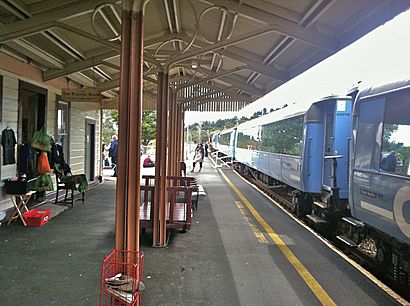Ohakune railway station facts for kids
Ohakune railway station is a train stop on the North Island Main Trunk (NIMT) line. It serves the town of Ohakune in the Manawatū-Whanganui region of New Zealand. For a while, it was called Ohakune Junction. This was to avoid confusion with another station on the Raetihi Branch line. The name changed back when the Raetihi Branch closed in 1968.
When the Overlander train was replaced by the Northern Explorer in 2012, the number of trains stopping at Ohakune changed. Now, only one train stops here each day, six days a week.
Quick facts for kids
Ohakune
|
||||||||||||||||||||||||||
|---|---|---|---|---|---|---|---|---|---|---|---|---|---|---|---|---|---|---|---|---|---|---|---|---|---|---|

Overlander at Ohakune in 2012. The low platform resulted in use of steps to ease access to coaches.
|
||||||||||||||||||||||||||
| Location | Thames Street, Ohakune New Zealand |
|||||||||||||||||||||||||
| Coordinates | 39°24′10″S 175°24′59″E / 39.402775°S 175.416384°E | |||||||||||||||||||||||||
| Elevation | 618 m (2,028 ft) | |||||||||||||||||||||||||
| Owned by | KiwiRail | |||||||||||||||||||||||||
| Line(s) | North Island Main Trunk | |||||||||||||||||||||||||
| Distance | Wellington 317.09 km (197.03 mi) | |||||||||||||||||||||||||
| Connections | Raetihi Branch (closed 1968) | |||||||||||||||||||||||||
| Construction | ||||||||||||||||||||||||||
| Parking | Yes | |||||||||||||||||||||||||
| History | ||||||||||||||||||||||||||
| Opened | 7 March 1908 (goods) 15 February 1909 (passenger) |
|||||||||||||||||||||||||
| Electrified | 25 kV 50 Hz AC June 1988 | |||||||||||||||||||||||||
| Previous names | Ohakune Junction in working timetables 1917–1968 | |||||||||||||||||||||||||
| Services | ||||||||||||||||||||||||||
|
||||||||||||||||||||||||||
| Designated: | 20 February 2009 | |||||||||||||||||||||||||
| Reference #: | 7790 | |||||||||||||||||||||||||
Contents
Station History
The Ohakune station building was built around 1908. It was a standard design called a "Class B" station. This station was very important for the town of Ohakune as it grew. Many famous trains have stopped here over the years. These include The Overlander, Blue Streak, Scenic Daylight, Northerner, and Silver Star.
Building the Railway
Planning for the railway line in this area started in 1894. The first trains arrived in Ohakune on November 5, 1907. At first, the Public Works Department (PWD) managed the railway. They worked with the New Zealand Railways Department (NZR) to arrange for both passengers and goods.
The station was quite basic at first. It had a platform about 30 meters (100 feet) long. Goods traffic, like moving supplies, started a bit later, in March 1908. The NZR officially took over the station from the PWD in February 1909.
Early Days and Facilities
On November 9, 1908, a stationmaster was appointed. The very first public train from Wellington to Auckland ran that day. Passengers even stayed overnight in Ohakune. Because there wasn't enough hotel space, people were allowed to sleep on the trains.
The NZR asked the PWD to finish the platform quickly. It was "dangerous for passengers landing in the dark." By March 1908, the station had a platform, a goods shed for storing items, and yards for loading cattle. It also had an engine shed, a turntable for turning engines around, and a passing loop for trains to wait.
By July 1909, more improvements were made. A "footwarmer house" was built, which was a special place to heat up footwarmers for train carriages. There was also a bookstall, offices, and rooms for ladies. The platform was made longer and paved. The goods shed was also made bigger in 1910.
Ohakune's Importance
Ohakune was a busy station. In 1923, it sold over 58,000 train tickets. It was also a major hub for sending timber by train. A huge amount of timber, about 280,437 board feet, was sent from Ohakune by rail. This shows how important the station was for the local timber industry.
Engine Sheds and Fires
The engine shed at Ohakune had a tough history with fires. It burned down in April 1905, but a new, larger one was built. This new shed could hold five locomotives. An ash pit was added in 1910. Sadly, this shed also burned down in December 1923.
In 1929, the turntable, which helps turn train engines around, was replaced with a larger one. By 1960, the engine depot was mainly used for engines from the Raetihi branch line. It caught fire again in February 1967.
Railway Homes and Signals
Several houses were built for railway workers between 1905 and 1965. A hostel for female staff who worked in the refreshment rooms was built in 1940.
In December 1966, a new system called Centralised Traffic Control (CTC) was put in place. This system helped manage train movements more efficiently than the old tablet signalling.

